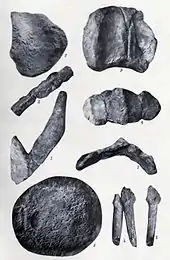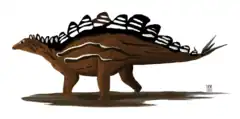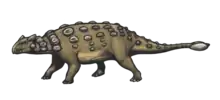| Stegopelta Temporal range: Early-Late Cretaceous, | |
|---|---|
 | |
| Pelvic armor | |
| Scientific classification | |
| Domain: | Eukaryota |
| Kingdom: | Animalia |
| Phylum: | Chordata |
| Clade: | Dinosauria |
| Clade: | †Ornithischia |
| Clade: | †Thyreophora |
| Suborder: | †Ankylosauria |
| Family: | †Nodosauridae |
| Subfamily: | †Nodosaurinae |
| Clade: | †Struthiosaurini |
| Genus: | †Stegopelta Williston, 1905 |
| Species: | †S. landerensis |
| Binomial name | |
| †Stegopelta landerensis Williston, 1905 | |
Stegopelta (meaning "roofed shield") is a genus of struthiosaurin nodosaurid dinosaur. It is based on a partial skeleton from the latest Albian-earliest Cenomanian-age Lower and Upper Cretaceous Belle Fourche Member of the Frontier Formation of Fremont County, Wyoming, USA.
History

In 1905, Samuel Wendell Williston described FMNH UR88, a partial armored dinosaur skeleton consisting of a maxilla fragment, seven cervical and two dorsal vertebrae, part of a sacrum and both ilia, caudal vertebrae, parts of the scapulae, both humeral heads, portions of an ulna and both radii, a metacarpal, partial tibia, metatarsal, and armor including a shoulder spine and neck ring.[1][2] The specimen was in poor condition, as it had eroded from a slope and been walked on by cattle.[3] Ankylosaurians being very poorly known, Williston compared his new genus to Stegosaurus, and the armor to that of Glyptodon;[1] like that mammal, Stegopelta had a fused section of armor (in its case over the pelvis). Roy Lee Moodie redescribed it in 1910, and considered it to be close to, if not the same as, Ankylosaurus.[3]
The genus fell into obscurity. Walter Coombs synonymized it with the more famous but equally poorly known Nodosaurus in his 1978 redescription of the Ankylosauria.[4] It was reinstated as a valid genus by Ken Carpenter and James Kirkland (1998), who recognized it as having distinct vertebral and armor characteristics.[2] Tracy Ford took this farther in 2000, assigning it to a new subfamily in Ankylosauridae based on armor characteristics, which he called Stegopeltinae. Also included was Glyptodontopelta.[5] This has not been generally accepted, but most recent reviews have accepted Stegopelta as a distinct genus with uncertain affinities.[6][7]
Paleobiology
Because it is so poorly known, at this point all that can be said about the habits and life of Stegopelta is that it was a slow quadrupedal herbivore that fed low to the ground and relied on its armor for defense.[7]
Its armor included a fused region over the sacrum, and shoulder spines that may have been split, as seen in Edmontonia.[2]
See also
References
- 1 2 Williston, S.W. (1905). "A new armored dinosaur from the Upper Cretaceous of Wyoming". Science. 22 (564): 503–504. Bibcode:1905Sci....22..503W. doi:10.1126/science.22.564.503-a. PMID 17748142.
- 1 2 3 Carpenter, K., and Kirkland, J.I. (1998). Review of Lower and middle Cretaceous ankylosaurs from North America. In: Lucas, S.G., Kirkland, J.I., and Estep, J.W. (eds.). Lower and Middle Cretaceous Terrestrial Ecosystems. New Mexico Museum of Natural History and Science Bulletin 14:249-270.
- 1 2 Moodie, R.L. (1910). "An armored dinosaur from the Cretaceous of Wyoming". Kansas University Science Bulletin. 5: 257–273.
- ↑ Coombs, W. P. Jr. (1978). "The families of the ornithischian dinosaur order Ankylosauria". Palaeontology. 21 (1): 143–170.
- ↑ Ford, T.L. (2000). A review of ankylosaur osteoderms from New Mexico and a preliminary review of ankylosaur armor. In: Lucas, S.G., and Heckert, A.B. (eds.). Dinosaurs of New Mexico. New Mexico Museum of Natural History and Science Bulletin 17:157-176.
- ↑ Carpenter, K. (2001). Phylogenetic analysis of the Ankylosauria. In: Carpenter, K. (ed.). The Armored Dinosaurs. Indiana University Press:Bloomington, 455–483. ISBN 0-253-33964-2
- 1 2 Vickaryous, M.K., Maryańska, T., and Weishampel, D.B. (2004). Ankylosauria. In: Weishampel, D.B., Dodson, P., and Osmólska, H. (eds.). The Dinosauria (second edition). University of California Press:Berkeley, 363–392. ISBN 0-520-24209-2
External links

